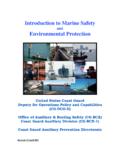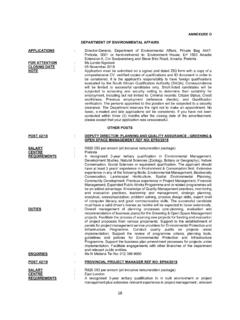Transcription of Edition - who.int
1 Primary Containment forBiohazards: Selection, Installation and Use of Biological Safety Cabinets2nd Department of Health and Human ServicesPublic Health ServiceCenters for Disease Controland PreventionandNational Institutes of HealthSeptember GOVERNMENT PRINTING OFFICEWASHINGTON: 2000iEDITORS:Jonathan Y. Richmond, , office of Health and SafetyCenters for Disease Control and PreventionAtlanta, GA 30333 Robert W. McKinney, , Division of SafetyNational Institutes of HealthBethesda, MD 20892iiCONTRIBUTORS:Centers for Disease Control and PreventionOffice of Health and SafetyRichard GreenTraining Activity Richard Knudsen, Safety Branch Henry Mathews, Safety Branch Michael WeathersLaboratory Safety Branch National Institutes of Health Division of SafetyEdward F.
2 Sorensen IIIO ccupational Safety andHealth BranchMichael L. SpillaneOccupational Safety andHealth BranchRonald TrowerOccupational Safety andHealth BranchDeborah E. Wilson, Safety andHealth BranchOther Contributors:Lee M. AldermanEmory UniversityAtlanta, GAManuel S. BarbeitoFrederick, MDJonathan Crane1201 Peachtree Street, NE400 Colony Square, Ste 600 Atlanta, GA 30361-3500 Diane O. Fleming, , MDDavid G. Stuart, Baker CompanySanford, MEiiiCONTENTSSECTION 1 SECTION IIThe High Efficiency Particulate Air (HEPA) Filter and theDevelopment of Biological Containment 3 HEPA 4 SECTION IIIB iological Safety 6 The Class I 6 The Class II 7 The Class III 12 Horizontal Laminar Flow "Clean Bench".
3 13 Vertical Laminar Flow "Clean Bench".. 13 SECTION IVLaboratory Hazards and Risk 14 Chemicals in 14 Radiological Hazards in the 16 Risk 16 SECTION VBSC Use by the Investigator: Work Practices and Procedures 18 Preparing for Work Within a Class II 18 Material Placement Inside the 20 Operations Within a Class II 22 Laboratory 24 SECTION VIFacility and Engineering 26 Secondary 26 Building 26 Utility 27 Ultraviolet 27 BSC 27 HEPA 28ivSECTION VIIC ertification of Biological Safety 30 Development of Containment 30 Performance Testing BSCs in the Velocity and Volume Velocity Smoke Patterns Filter Leak Leak Leakage and Ground Circuit Resistanceand Polarity
4 Intensity Level Lamp 50vTABLEST able 1. Selection of a Safety Cabinet Through Risk 36 Table 2. Comparison of Biosafety Cabinet 37 Table 3. Performance Tests to be Applied to the Three Classes of Biological Safety Cabinets .. 38 Table 4. References for Applicable Containment 39viFIGURESF igure 40 Figure Class I 41 Figure Class II, Type A 41 Figure 42 Figure Class II, Type B1 BSC (classic design).. 42 Figure Class II, Type B1 BSC (bench top design).. 43 Figure Class II, Type B2 44 Figure tabletop model of a Class II, Type B3 44 Figure Class III 45 Figure horizontal laminar flow "clean bench".
5 45 Figure vertical laminar flow "clean bench".. 45 Figure modified containment cabinet or Class I 46 Figure typical layout for working "clean to dirty".. 47 Figure method to protect a house vacuum 47 Figure bag-in-bag-out filter 481 SECTION I IntroductionThis text presents information on the design, selection,function and use of biological safety cabinets (BSCs), which arethe primary means of containment developed for working safelywith infectious microorganisms. Brief descriptions of the facilityand engineering concepts for the conduct of microbiologicalresearch are also provided.
6 BSCs are only one part of an overallbiosafety program which requires consistent use of goodmicrobiological practices. Detailed descriptions of acceptablework practices, procedures, and facilities, described as biosafetylevels 1 through 4, are presented in the CDC/NIH publicationBiosafety in Microbiological and Biomedical Laboratories (BMBL) are designed to provide personnel, environmentaland product protection when appropriate practices andprocedures are followed. Three kinds of biological safetycabinets, designated as Class I, II and III have been developed tomeet varying research and clinical efficiency particulate air (HEPA) filters or ultra-lowpenetration air (ULPA) filters are used in the exhaust and/orsupply systems of biological safety cabinets These filters andtheir use in BSCs are briefly described in Section II.
7 Section IIIpresents a general description of the special features integratedinto biological safety cabinets to provide varying degrees ofpersonnel, product and environmental hazards and risk assessment are discussed inSection IV. Section V presents the laboratorian with workpractices, procedures and practical tips to maximize the protec-tion afforded by the most commonly used BSCs. Facility andengineering requirements needed for the operation of each type ofBSC are presented in Section VI. Finally, Section VII reviewssome of the requirements for routine annual certification ofcabinet operation and sections are not meant to be definitive or all-encompassing.
8 Rather, an overview is provided to clarify theexpectations, functions and performance of these critical primaryIntroduction2barriers. This document has been written for the laboratorian,engineer, manager, or procurement officer who desires a betterunderstanding of each type of cabinet and the rationale forselecting the appropriate BSC to meet specific operational IIThe High Efficiency Particulate Air (HEPA) Filter andthe Development of Biological Containment DevicesFrom the earliest laboratory-acquired typhoid infections tothe hazards posed by today's antibiotic-resistant bacteria andrapidly-mutating viruses, threats to worker safety have stimulatedthe development and refinement of cabinets in which infectiousmicroorganisms could be safely handled.
9 Work with cell cultures,the need to maintain sterile cell lines, and the need to minimizecross-contamination to maintain product integrity were alsoaddressed in the design of use of proper microbiological procedures, aseptictechniques, and equipment (as described in BMBL)6 cannot beoveremphasized in providing primary personnel and environmentalprotection. For example, high-speed blenders designed to reduceaerosol generation, needle-locking syringes, microburners, andsafety centrifuge cups or sealed rotors are among the engineeringdevices that protect the laboratorian.
10 However, the mostessential piece of containment equipment is the biological safetycabinet in which manipulations of microorganisms are prototype clean air cubicles were designed toprotect the materials being manipulated from contamination ( ,from the room or from the worker), rather than to protect theworker from the risk of manipulating the materials. Filtered airwas blown across the work surface directly at the worker. Therefore, these cubicles could not be used for handlinginfectious agents, because the worker would be in acontaminated air protect the worker during manipulations of infectiousagents, a small workstation was needed that could be installed inexisting laboratories with a minimum of modification to the room.
















